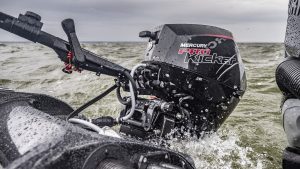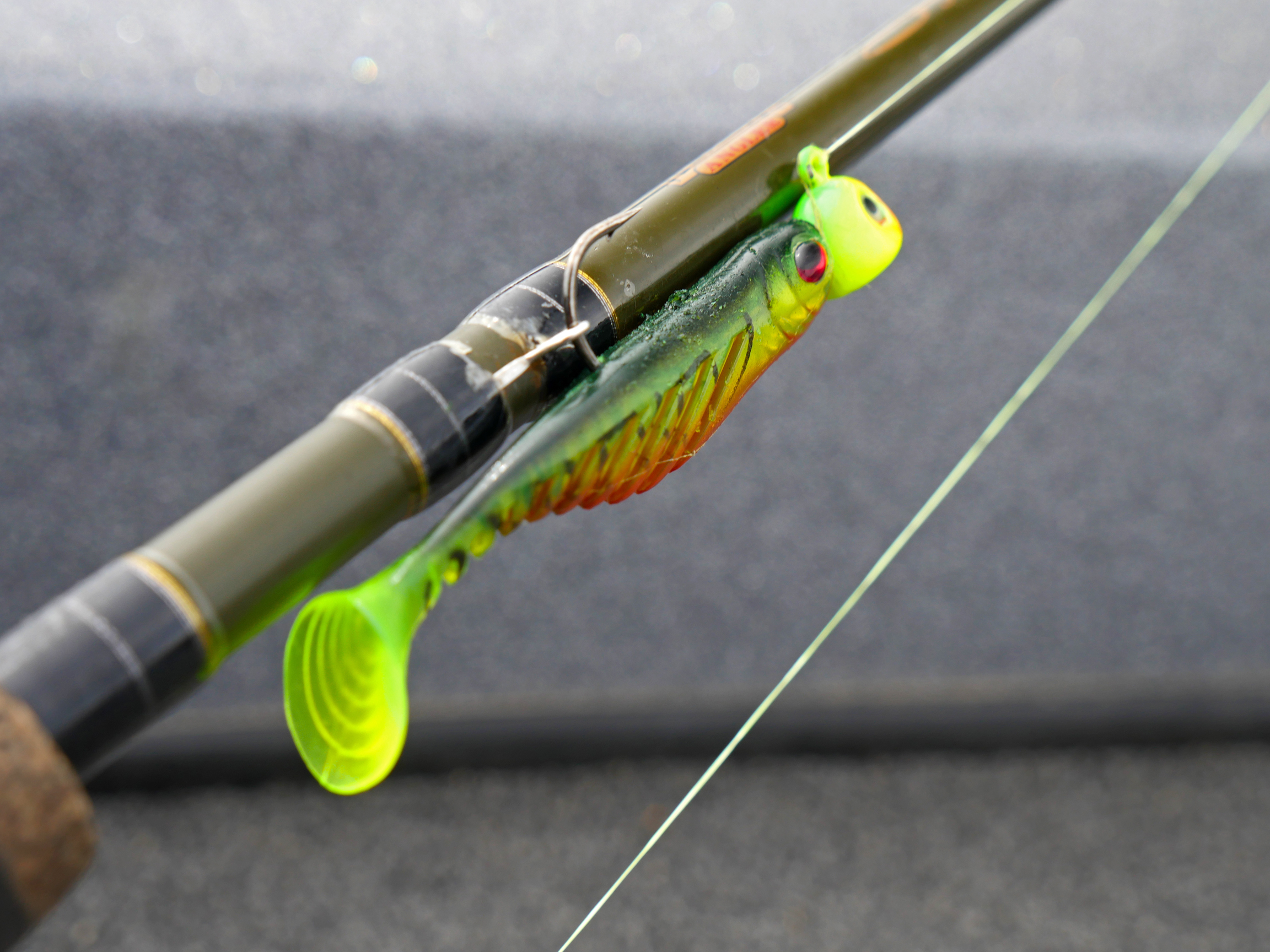
Your 1000-acre local lake fishes just fine with a 16-foot johnboat, a 25-hp motor, 12V tiller electric, and a 5” sonar. Take this rig too far out into Green Bay, across Mille Lacs, or for a 50-mile run up a Missouri Reservoir, and you quickly learn the value of the modern multispecies machine.
Our Nitro ZV21s show up in early February (this year with a 400hp Mercury Verado) giving us a few weeks to customize and adjust the build with this year’s technology. Most of this effort results in comfort, speed, and safety on the big water. The rest optimizes our ability to put a lure in front of the fish.
Without power the boat is literally dead in the water. The outboard needs to start and the trolling motor must run all day as needed. For most boat owners, battery replacement is the least exciting cost to boat ownership so it pays to focus on battery maintenance. The big change in power this year is the CHARGE marine power management station by Power Pole. This is the first system that allows bi-directional power management throughout a bank of batteries along with the ability to use the alternator to charge every battery on the boat.
Bi-directional battery management means that if your sonar and livewells have put a drain on the system you can pull from either the cranking battery or the trolling motor bank to start the main engine. Conversely, if all batteries run low at the end of the day, the system can gather any remaining charge at the starter battery, turn over the main engine, then, just as importantly, allow the alternator to recharge the entire system Plus, all of the battery systems can be monitored online (via smartphone) or even directly on a Lowrance Sonar unit (with a CM2 gateway).
With guaranteed power running multiple sonar units is no longer a hassle. Two Electronic units at the console and one or two at the bow, handle mapping and fish finding. If you watched us while fishing you would see that we regularly change the view on both systems depending on the situation and two units allow us to view a map, active imaging (down and side), and/or 2D sonar on a full screen while still monitoring the other views.
New boats need rod holders and other small accessories to tie the whole package together. For rough water, all-metal designs work best and are the toughest, so we use Cisco electronics mounts, rod holders, and trolling motor supports. Our rod holders are either track or rail mounted so we can adjust from lead core to planer board spreads in an instant while the solid design (machined aluminum) lets us troll super snaggy situations, like spinner-baits in the trees with confidence. We consider these a lifetime investment and love using them.
Rough water running does a number on longer walleye-style trolling motor shafts. The heavy head on the trolling motor bounces around and can even hit the deck on rough landings so a motor stabilization system is a must. We like the no-straps, heavy-duty, easy to deploy design of the Cisco Trolling Motor Stabilizer.
The Nitro ZV21 has excellent tackle, net, and accessory storage. The one item we add is a magnetic lure holder like the T-H Marine Tackle Titan. It has magnets strong enough to hold even #3 Shiver minnows and allows us to conveniently hang lures as we go through colors and sizes without a bunch of baits cluttering the boat.
The rest of the big water accessories help with boat control. The unique Power Pole Blade and Drift Paddle system replaces a drift sock (thus freeing up storage space on the boat). The poles provide shallow water anchoring in depths up to eight feet (with a 10-foot Blade) which we use while casting, but also to anchor the boat easily as we pull into docks or pull up to shore. The Drift Paddles work as sea anchors while trolling or drifting baits. Since the paddles deploy with the push of a button and micro-adjust paddle angle, they provide immediate and superior control in all wind conditions.
Our Mercury 15hp Pro Kicker motors fill in all of the other boat control details. When trolling, it provides all-day propulsion between 1.5 and 3.5 mph while also fighting the wind. To augment that control we install the PowrTran Tailfin remote kicker steering system. This allows us to dial in our kicker direction position from a key fob just as easily as the electric motor up front. Modern walleye boats have larger livewells and storage at the stern making it tough to run the kicker with a traditional tiller handle and the Tailfin give us the ability to fish from the most efficient spot in the boat based on the technique we are using.
Some of our tournaments and video days require an hour or more of running in rough water to the fishing spots. To maximize safety, fuel efficiency, and speed we use three major boat accessories to fine tune performance in any conditions. The traditional motor tilt and trim takes care of thrust angle, an Atlas HD jack plate allows vertical engine adjustment, and PowrTran ProTabs align the hull with the conditions.
In calm conditions, while running, the tilt and jack plate work together to lift the hull out of the water and reduce drag. Having the lower unit deep under water is great for hole shots, but slows down top end speed. While bass anglers love a jack plate for shallow water starts, walleye anglers use it when running wide open to tweak the motor position and reduce engine drag in the water resulting in more speed.
Another situation where we use the Atlas HD Jack is when we are in medium-sized waves. By trimming the motor completely down and then raising the jack plate, we can make the boat run flat and span the tops of the waves.
In rough water, every time a wave kicks the boat up, it must also come down. These re-entries can be managed by skilled boat driving along with PowrTran Pro Tab trim tabs. The tabs work to push the nose of the boat down to maintain water contact in larger waves. This keeps the boat in the water instead of hopping off one wave and pounding into the next wave. Just be careful to not push the bow down so quickly that the boat spears the next wave. Our ZV boats have an excellent rebound making it much more difficult to spear waves – but each boat is different.
By having the ability to adjust each of the two ProTabs separately, trim tabs are also great for changing the side to side attitude of the boat. This allows us to adjust for weight differences (2 anglers on one side, one on the other) and makes the boat run flat. Or we can intentionally tip the boat so that oncoming side waves hit more of the bottom of the boat than slamming into the side. This will make the ride not only softer but also drier.
One item that many anglers overlook to help a deep V boat perform better is the type of prop the engine is rigged with. For example, we use the Mercury Bravo I LT which has an extended and flared tube to provide additional stern lift. Stern (or back) lift is just as important for speed as getting the nose of the boat lifted. LT is a little thing that gives us better performance.
Having competed in the early years of walleye tournaments seat suspension is probably the best improvement for boating comfort. Combine these seats with the modern hull designs and sore backs are now a thing of the past even when making long rough runs. When choosing a system obviously you want the suspension to provide a cushioned ride when hitting a wave. But a big feature to compare is rebound. If the suspension pushes you up faster than the boat it can be more like riding a pogo stick making it hard to stay in the seat. Also consider how “clean” the system is when installed under the seat. You want a system that does not have a lot of clutter which tend to grab net bags, entangle lines or stub toes. We tried several, but use AirWave seats on our rigs.
Since we change boats every year we try out, tweak, and learn to rely on these accessories. Being on the water for tournaments and filming, we test these accessories on a daily basis. In the end, all of these details add up so we can maintain a constant focus on getting – The Next Bite!










